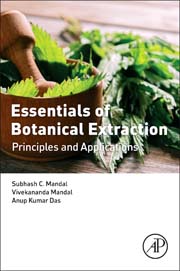
Essentials of Botanical Extraction: Principles and Applications
Mandal, Subhash C.
Mandal, Vivekananda
Das, Anup Kumar
Today most extracts obtained from botanicals are poorly characterized with unidentified active or inactive constituents, having stability related issues with erratic quality profile. In research leading to drug discovery from medicinal plants, extraction is one of the important steps as it is the starting point for the isolation and purification procedures. An imprudent selection of an extraction method can cause the entire extraction process to fall apart thus can jeopardize the entire objective of isolating a bioactive compound. A poorly prepared extract is sufficient enough to invalidate even the most powerful separation technique. In addition, the eco-friendly aspect of an extraction process should be taken into consideration with reference to less solvent and power consumption with a sole aim to exterminate the various perilous impacts on environmental and human health. Thus the development of a modern extraction strategy with significant advantages over conventional methods is the need of the hour. Essentials of Botanical Extraction: Principles and Applications provides a unique, single source of valuable information on the various methods available, from conventional techniques to the use of green and modern extraction technologies including ultrasounds, microwaves, pressurized liquids and supercritical fluids. The book explores the kinetics and mathematical hypothesis which underpin all extraction processes, as well as the significant technical advancements in both conventional and modern extraction techniques which have accelerated the sample preparation steps. Detailing the fundamentals and practical applications for botanical sample preparation and analysis, this work is a valuable resource for analytical chemists, pharmacognosists, medicinal chemists, and others working in R&D for pharmaceutical companies and academic settings, as well as graduate level students in these and related studies such as phytochemistry, ethnopharmacology, phytotherapy, botany, and medicinal plants. Reviews the history and current state of Natural Product drug discovery and development, highlighting successes and current issuesExplains the application of chemometric tools in extraction process designing and method developmentIntroduces process intensification as applied to the processing of medicinal plant extracts for rapid and cost-effective extraction INDICE: 1. Introduction 2. History and Background on the Use of Natural Products Obtained From Plants as Therapeutic Agents 2.1. A General Overview 2.2. Drug Usage During Prehistoric Period 2.3. Developments and Drug Usage During Ancient Times/Pre-Hellenic Civilizations 2.4. Drug Discovery and Development During the Middle Ages 2.5. Developments and Drug Usage During Last Phases of Middle Ages 3. Botanicals as a Screening Source of New Drugs: Past Success Stories and Present Day Concerns 3.1. Historic Role of Botanicals 3.2. Botanicals as Sources of New Leads Over the Past Three Decades 4. What All Should Know About Plant Drugs 4.1. Role of Plants in Drug Development 4.2. Factors Thought to be the Reason for Declining Interest in Botanicals 4.3. Approaches and Strategies to Improve the Status of Drug Discovery from Botanicals 4.4. Approaches to Medicinal Plant Selection Prior to Extraction 4.5. An Overview on Pre-Extraction Techniques 5. Extraction of Botanicals 5.1. Understanding the Link Between Botanical Extraction and their Standardization 5.2. General Extraction Approaches and Theories 5.3. Factors Affecting Extraction of Botanicals 6. Classification Of Extraction Methods 6.1. Classification of Various Non-Conventional Extraction Techniques 6.2. Removal of Unwanted and Interfering Components After Extraction 7. Innovative Extraction Process Design and Optimization 7.1. Terminologies We Need to Know 7.2. Issues Related to Design of Experiments 7.3. Response Surface Methodology (RSM) as a Tool for Optimization in Microwave Assisted Extraction (MAE) 7.4. Response Surface Methodology (RSM) as a Tool for Optimization in Supercritical Fluid Extraction (SFE) 7.5. Response Surface Methodology (RSM) as a Tool for Optimization in Accelerated Solvent Extraction (ASE) 8. Identification Strategies Of Phytocompounds 8.1. Identification Strategy for Volatile Compounds 8.2. Identification Strategy for Non-Volatile Compounds 8.3. Identification of Known Compounds Using Reference Standards 8.4. Identification of Known Compounds Without Reference Standards 8.5. Identification of Compounds with Unknown Structure 8.6. Stages in Structure Elucidation 9. Qualitative Phytochemical Screening 9.1. Alkaloids 9.2. Glycosides 9.3. Terpenoids 9.4. Steroids 9.5. Flavonoids 9.6. Coumarin Drugs 9.7. Essential Oil 9.8. Carbohydrate 9.9. Tannins and Phenolic Compounds 9.10. Proteins and Amino Acids 9.11. Spray Reagents 10. Profiling Crude Extracts for Rapid Identification of Bioactive Compounds 10.1. Techniques Routinely Employed in Dereplication Study 10.2. Stages Where Dereplication is Applied During Drug Discovery from Botanicals 10.3. Construction and Characterization of Crude Extract Libraries
- ISBN: 978-0-12-802325-9
- Editorial: Academic Press
- Encuadernacion: Rústica
- Páginas: 230
- Fecha Publicación: 16/02/2015
- Nº Volúmenes: 1
- Idioma: Inglés
